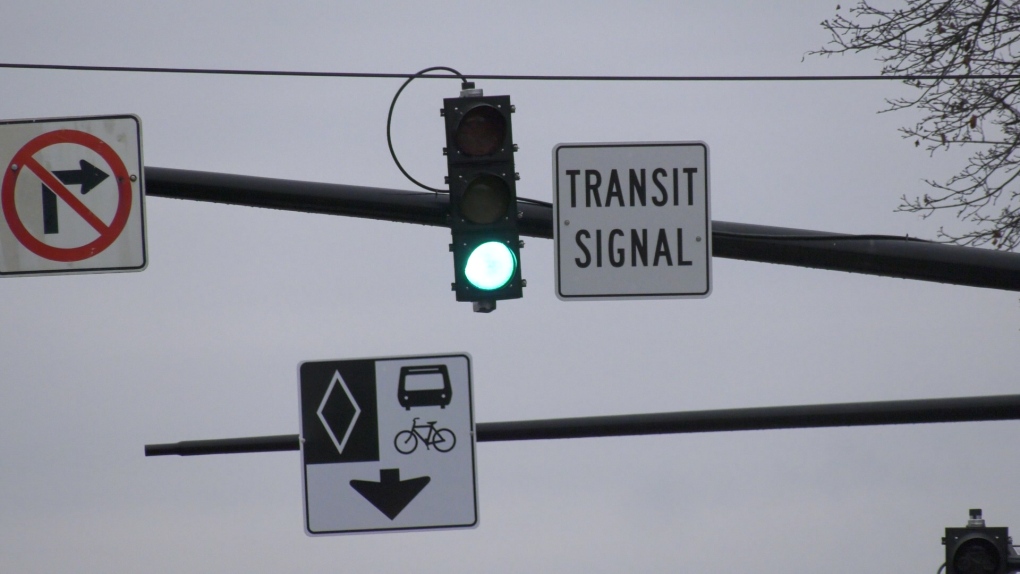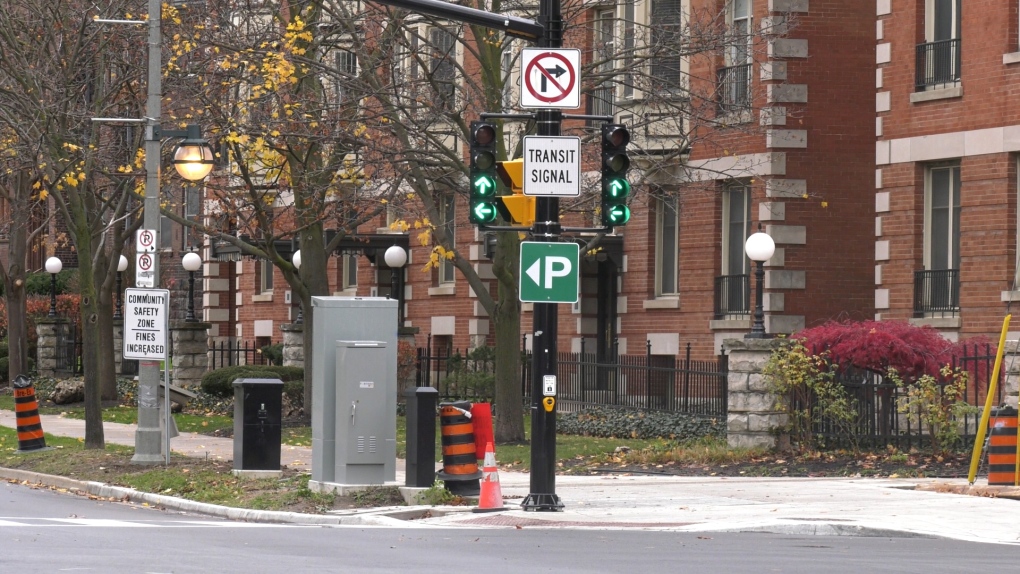'It will definitely be much faster': New BRT traffic signals help keep buses moving in the downtown
A London Transit bus sits in the outside lane of southbound Ridout Street. Then it suddenly twists in front of waiting cars to head east on King Street. It's part of the new traffic signal addition for the downtown Bus Rapid Transit (BRT) loop.
The downtown BRT traffic signals went into use on Monday.
"We've made them visually distinct. The transit signals, they're black. The flights have a smaller lens. They have a sign right beside them that says 'Transit Signal' and they're usually located right over top of that transit lane,” said Jennie Dann, London’s Construction and Infrastructure director.
At Ridout and King, there are separate traffic signals for cyclists, London Transit, and the traditional larger yellow traffic light for all other vehicles.
Currently, buses turning onto Ridout from Dundas would have to quickly cross lanes in order to reach the left turn lane at King. Now they don’t have to cross those lanes.
 New transit traffic lights and signs are in use in London's downtown, seen on Nov. 26, 2024, (Gerry Dewan/CTV News London)Dann told CTV News, the BRT traffic signals are part of the effort to use the dedicated bus lanes to enhance overall traffic performance, "They do improve transit reliability and frequency, but they also improve traffic congestion because you're getting those buses out of mixed traffic. And so, they have that transit signal that gives them the priority. It allows them to be able to make multiple movements from that outside lane."
New transit traffic lights and signs are in use in London's downtown, seen on Nov. 26, 2024, (Gerry Dewan/CTV News London)Dann told CTV News, the BRT traffic signals are part of the effort to use the dedicated bus lanes to enhance overall traffic performance, "They do improve transit reliability and frequency, but they also improve traffic congestion because you're getting those buses out of mixed traffic. And so, they have that transit signal that gives them the priority. It allows them to be able to make multiple movements from that outside lane."
Clair said she's been riding London Transit for about 25 years. She said she always had sympathy for bus drivers who didn't get much cooperation from other drivers, "If the people were respectful and wait but I mean, you know, they'd just cut them off."
Ronie Ninziza travels from west London to the downtown, where she works. She’s hopeful the new signals and dedicated lanes will improve traffic flow, making it a quicker, more reliable journey, "The stops would really delay us most of the time and you wouldn't know. It would depend on the traffic. With them being able to just move around it will definitely be much faster."
 London Transit buses get their own traffic signals in the downtown, seen on Nov. 26, 2024, (Gerry Dewan/CTV News London) Joel Frank goes from south London to Fanshawe College, a journey he said takes over an hour, sometime over two hours. He's anxious to cut down that commute, “So, just today is the first time I really noticed it and that it did make a difference. It was much, much quicker than it usually is.”
London Transit buses get their own traffic signals in the downtown, seen on Nov. 26, 2024, (Gerry Dewan/CTV News London) Joel Frank goes from south London to Fanshawe College, a journey he said takes over an hour, sometime over two hours. He's anxious to cut down that commute, “So, just today is the first time I really noticed it and that it did make a difference. It was much, much quicker than it usually is.”
The City of London has a dedicated web page that breaks down what the BRT lights, signs and lane markings mean. The big ask from the city is that the bus lanes be kept clear, "It's really important that vehicles don't stop or park in that lane because what that does is it stops the frequency and reliability of the transit operations. But it also creates a safety concern because now those buses have to weave back into general traffic."
In the meantime, work continues on the south and east legs of the Bus Rapid Transit project.
CTVNews.ca Top Stories

BREAKING N.S. Progressive Conservatives win second majority government; NDP to form opposition
For the second time in a row, Tim Houston's Progressive Conservatives have won a majority government in Nova Scotia. But this time, the NDP will form the official opposition.
Paul Bernardo denied parole after victims' families plead he be kept behind bars
Notorious killer and rapist Paul Bernardo has been denied parole for a third time after the families of his victims made an emotional plea to the Parole Board of Canada on Tuesday to keep him behind bars.
'We would likely go out of business': Canadian business owners sound the alarm over Trump's tariffs
Business leaders across Canada are voicing concerns and fear over the widespread impact increased tariffs could have on their companies and workers, with some already looking to boost sales in other markets in the event their products become too expensive to sell to American customers.
Israel, Hezbollah agree to ceasefire brokered by U.S. and France, to take effect Wednesday
A ceasefire between Israel and Iran-backed group Hezbollah will take effect on Wednesday after both sides accepted an agreement brokered by the United States and France, U.S. President Joe Biden said on Tuesday.
Longtime member of Edmonton theatre community dies during 'A Christmas Carol' performance
Edmonton's theatre community is in mourning after an actor died during a performance of "A Christmas Carol" at the Citadel Theatre on Sunday.
'We need to address those issues': Alberta Premier Danielle Smith won't denounce Trump tariff threat
Alberta Premier Danielle Smith says Canada should address U.S. president-elect Donald Trump's border concerns in the next two months, before he's back in the White House, instead of comparing our situation to Mexico's and arguing the tariff threats are unjustified.
Loonie tanks after Trump threatens tariffs on Canadian goods
The Canadian dollar fell to its lowest level since May 2020 after Donald Trump threatened to impose tariffs on Canadian goods shipped to the United States once he takes office in January.
Should Canada retaliate if Trump makes good on 25 per cent tariff threat?
After U.S. president-elect Donald Trump threatened to impose a 25 per cent tariff on all Canadian imports on his first day back in the White House unless his border concerns are addressed, there is mixed reaction on whether Canada should retaliate.
'We need to do better': Canadian leaders respond to Trump's border concerns
As U.S. president-elect Donald Trump threatens Canada with major tariffs, sounding alarms over the number of people and drugs illegally crossing into America, Conservative Leader Pierre Poilievre and some premiers say they agree that more could be done.
































